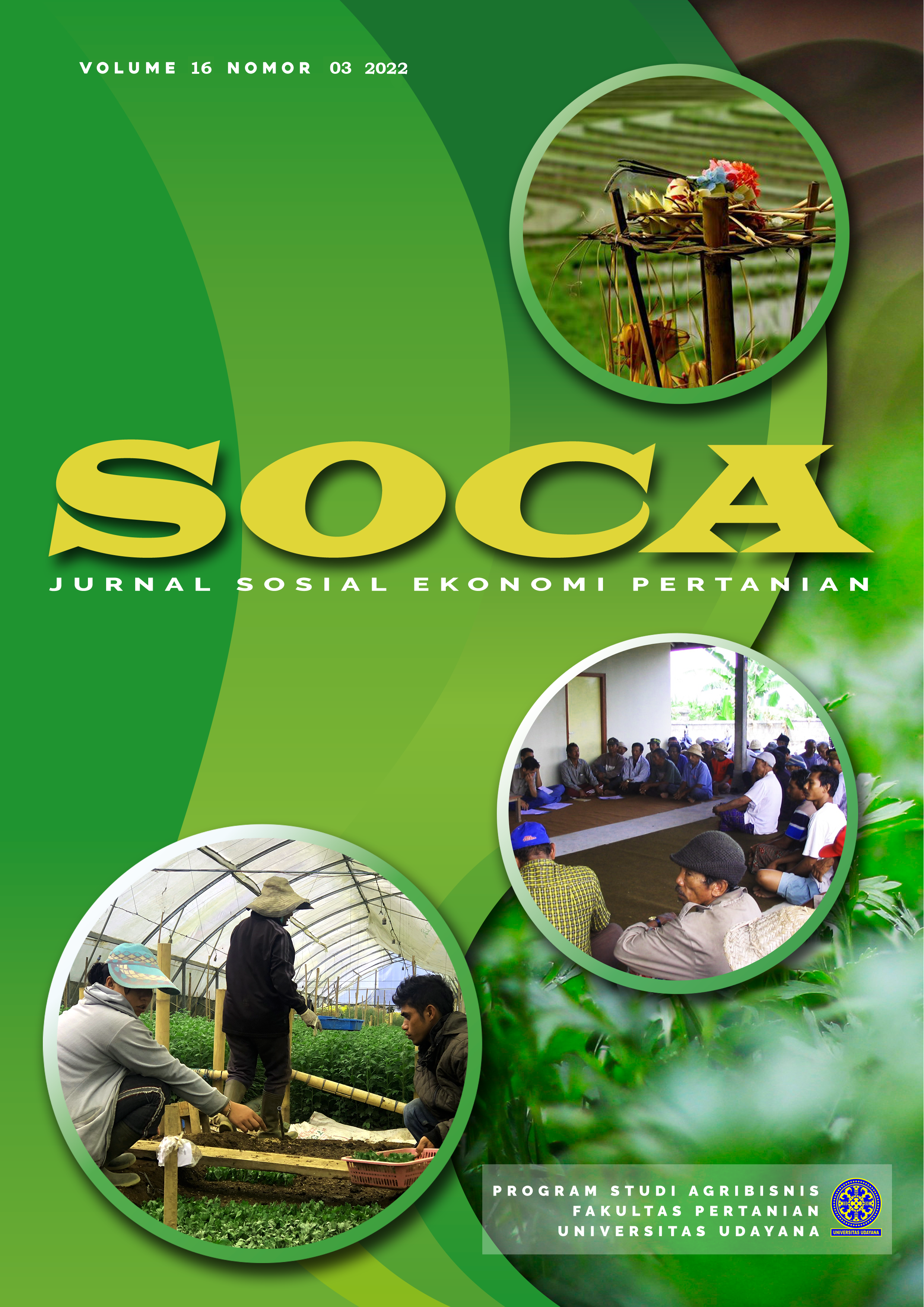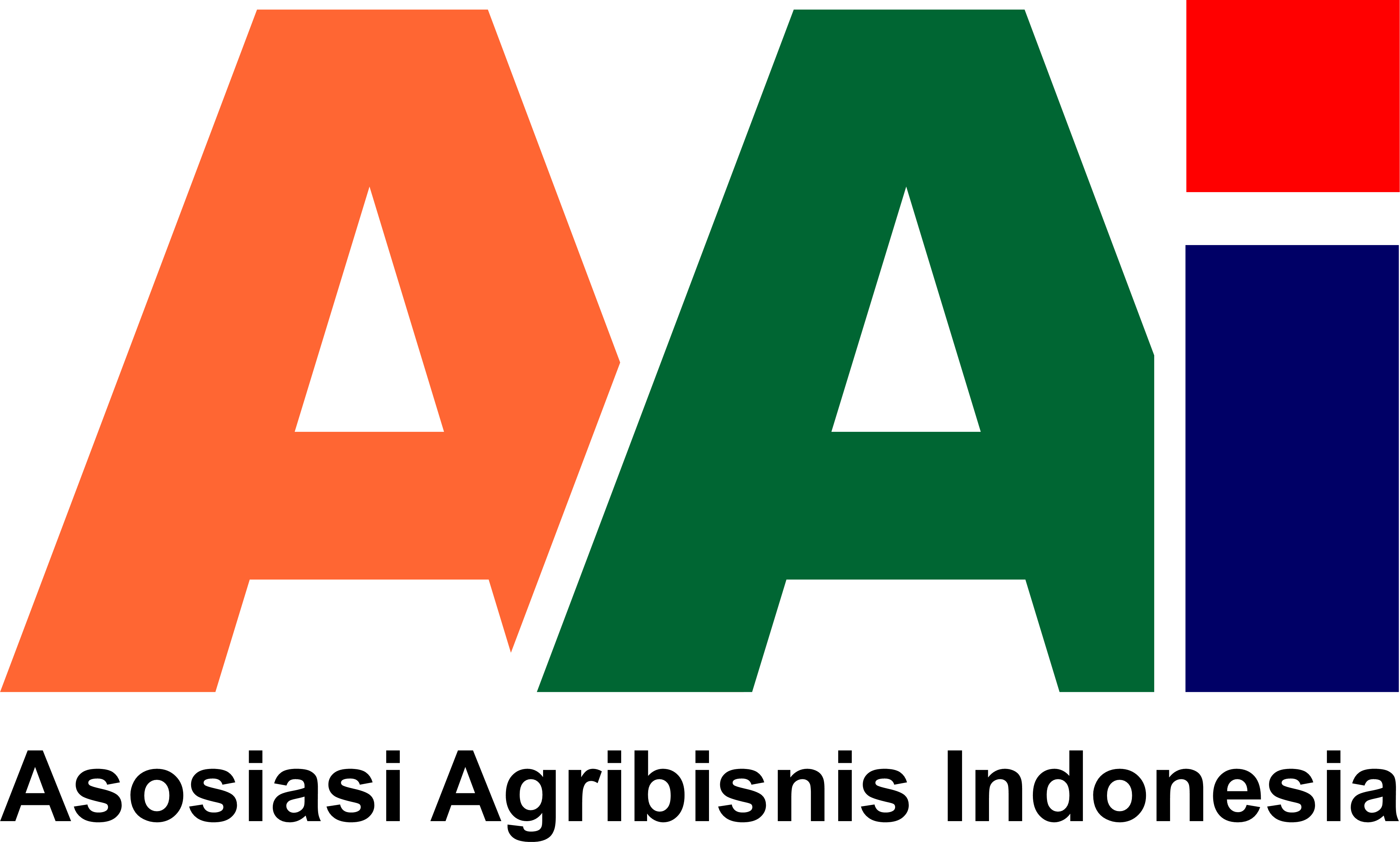Farmers’ Willingness to Pay Bio-Activators to Maintain Soil Fertility
Abstract
How farmers are willing to pay bio-activators needs to be
studied. The purposes of this study are to analyze the
knowledge and use of bio-activators, as well as the
willingness to pay for bio-activators in rice farming. The
research was conducted in Malang Regency, with a sample
of 82 farmers from Ngajum and Gondanglegi Districts. Data
were analyzed by descriptive and multiple linear regression.
The results showed that the farmers are aware of one to
four brands of bio-activators, and three of the brands are
used by the rice farmers. The benefits of using bioactivators
that are mostly perceived by rice farmers are
fertilizing the soil and plants, thereby increasing the
production of rice farming. Willingness to pay for bioactivators
is based on the prevailing market price, there is
no willingness to pay a premium price. Factors that have a
positive effect on willingness to pay are land area and
benefits of bio-activators. The wider the agricultural land
owned by the farmer and the greater the perceived benefits,
the greater the value of willingness to pay will be. This
information can be taken into consideration for
manufacturers of bio-activators as a new introduction
before being released in the market.
Downloads
References
Anisuzzaman, M., Rafii, M. Y., Jaafar, N. M., Ramlee, S. I., Ikbal, M. F., & Haque, M. A. (2021). Effect of organic and inorganic fertilizer on the growth and yield components of traditional and improved rice (Oryza sativa l.) genotypes in malaysia. Agronomy, 11(9), 1–22. https://doi.org/10.3390/agronomy11091830
Ariadi, B. Y., Relawati, R., Szymoniuk, B., & Khan, W. A. (2021). The Factors Influencing Purchase and Willingness to Pay for Organic Vegetables. Sarhad Journal of Agriculture. https://doi.org/10.17582/journal.sja/2022.37.s1.207.218
Doni, F., Radziah, C., Mohd, C., Isahak, A., Fathurrahman, F., Anhar, A., Nur, W., Mohtar, W., & Yusoff, W. (2018). A simple, efficient, and farmer-friendly Trichoderma-based biofertilizer evaluated with the SRI Rice Management System. Journal of the International Society of Organic Agriculture Rese, 8(3), 207–223. https://doi.org/10.1007/s13165-017-0185-7
Etim, N.-A., & Benson, D. (2016). Willingness to Pay for Organic Fertilizer by Resource Poor Vegetable Farmers in the Humid Tropic. Journal of Agriculture and Ecology Research International, 6(2), 1–11. https://doi.org/10.9734/jaeri/2016/20230
Farikhah, S., Fatimah, N., & Luthfi, A. (2018). Pemberdayaan Masyarakat Desa Melalui Program Integrated Ecofarming (Studi Kasus di Desa Asinan Kecamatan Bawen Kabupaten Semarang). SOCA: Journal on Socio-Economics of Agriculture and Agribusiness, 12(1), 1–14. https://doi.org/10.24843/soca.2018.v12.i01.p01
Franco Junior, K. S., Florentino, L. A., Dias, M. de S., & Franco, T. C. (2019). Influence of the use of coverage plants and the bio-activators in the physical-biological characteristics of soil cultivated with coffee. Coffee Science, 14(1), 116–122. https://doi.org/10.25186/cs.v14i1.1553
Gujarati, D. (2005). Basic Econometrics (4th ed.). McGraw Hill international edition, economics series.
Halkos, G., & Matsiori, S. (2012). Determinants of willingness to pay for coastal zone quality improvement. Journal of Socio-Economics, 41(4), 391–399. https://doi.org/10.1016/j.socec.2012.04.010
Hilmiati, N. (2020). Farmer Group Institution’s Typology and Agricultural Innovation Implementation Sustainability. SOCA: Jurnal Sosial, Ekonomi Pertanian, 14(2), 204. https://doi.org/10.24843/soca.2020.v14.i02.p02
Jones, N., Malesios, C., & Botetzagias, I. (2009). The influence of social capital on willingness to pay for the environment among European citizens. European Societies, 11(4), 511–530. https://doi.org/10.1080/14616690802624168
Kai, S. B., Chen, O. B., Chuan, C. S., Seong, L. C., & Kevin, L. L. T. (2013). Determinants of willingness to pay of organic products. Middle East Journal of Scientific Research, 14(9), 1171–1179. https://doi.org/10.5829/idosi.mejsr.2013.14.9.1959
Kuntariningsih, A., & Mariyono, J. (2014). Adopsi Teknologi Pertanian Untuk Pembangunan Pedesaan: Sebuah Kajian Sosiologis. Agriekonomika, 3(2), 180–191. https://doi.org/10.21107/agriekonomika.v3i2.453
Kuwornu, J. K. M., Narh Jnr, A. B., Egyir, I. S., Onumah, E. E., & Gebrezgabher, S. (2017). Willingness to pay for excreta pellet fertilizer: Empirical evidence from Ghana. Acta Agriculturae Slovenica, 109(2), 165–173. https://doi.org/10.14720/aas.2017.109.2.14
Muhammad, Bacha, M. S., & Shah, S. A. A. (2020). Urban farmers willingness to pay for organic fertilizer in District Mardan, Khyber Pakhtunkhwa, Pakistan. Sarhad Journal of Agriculture, 36(2), 419–426. https://doi.org/10.17582/JOURNAL.SJA/2020/36.2.419.426
Munardi, & Situmorang, D. (2018). Faktor-Faktor yang Mempengaruhi Tingkat Kesejahteraan Petani Sawit di Kecamatan Gunung Meriah Kabupaten Aceh Singkil. Jurnal Ekonomi Pertanian Unimal, 1(1), 23. https://doi.org/10.29103/jepu.v1i1.788
Ningsih, K., Sakdiyah, H., Felani, H., Dwiastuti, R., & Asmara, R. (2019). Analisis Kesediaan Membayar (Willingness to Pay) Masyarakat Terhadap Pertanian Organik Buah Naga. Agriekonomika, 8(2), 143–155. https://doi.org/10.21107/agriekonomika.v8i2.5425
Priyadi, R., Juhaeni, A. H., Meylani, V., & Fudholi, A. (2022). The Development of Inorganic Fertilizer and Bio-Fertilizer Combination and the Effectiveness of Application on the Growth and Production of Red Chili The Development of Inorganic Fertilizer and Bio-Fertilizer Combination and the Effectiveness of Applicati. March. https://doi.org/10.18280/ijdne.170111
Rahayuningsih, S. D., & Tain, A. (2021). Consumers willingness to pay and factors affecting organic vegetable purchasing decisions. Agriecobis: Journal of Agricultural Socioeconomics and Business, 4(1), 01–12. https://doi.org/10.22219/agriecobis.v4i1.15506
Rahmad, R., Karim, A., La Nafie, N., & Jayadi, M. (2019). Synthesis of Liquid Organic Fertilizer Based on Chicken Manure Using Biosca and Fungus Bioactivator Trichoderma Harzianum. Jurnal Akta Kimia Indonesia (Indonesia Chimica Acta), 11(2), 28. https://doi.org/10.20956/ica.v11i2.6489
Relawati, R., Ariadi, B. Y., & Harpowo. (2021). Customer’s behavior and willingness to pay for the antioxidant eggs. Psychology and Education, 58(1), 1302–1309. https://doi.org/10.17762/pae.v58i1.896
Relawati, R., Szymoniuk, B., Ariadi, B. Y., & Handayanto, E. (2022). Pricing Strategy for the Organic Eggs: Willingness to Pay and Hedonic Price Approaches. SOCA: Jurnal Sosial Ekonomi Pertanian, 16(1), 781–792. https://doi.org/https:/doi.org/10.24843/SOCA.2022.v16.i01.p11
Sasmito, P. (2017). Adopsi Inovasi Budidaya Kambing Peranakan Etawa (Pe) Di Kabupaten Kulon Progo Provinsi D.I. Yogyakarta. Komuniti: Jurnal Komunikasi Dan Teknologi Informasi, 8(5), 85–95. https://doi.org/10.23917/komuniti.v8i5.2142
Saufie, S., Estim, A., & Shaleh, S. R. M. (2022). Effect of Biofertilizers on the Integrated Culture of Genetically Improved Farmed Tilapia and Green Beans in Aquaponics. Aquaculture Studies, 22(3). https://doi.org/10.4194/AQUAST729
Shivanand, P., & Taha, H. (2022). Performance of a selected Trichoderma strain as plant pathogen inhibitor and biofertilizer. Malaysia Journal of Microbiology, 18(4), 446–454. https://doi.org/10.21161/mjm.211347
Shohib, A. (2020). Pembuatan Pupuk Organik dari Kotoran Sapi dan Jerami Padi dengan Proses Fermentasi Menggunakan Bioaktivator M-Dec. Inovasi Teknik Kimia, 5(1), 32–37. https://doi.org/10.31942/inteka.v5i1.3399
Tully, S. M., & Winer, R. S. (2014). The role of the beneficiary in willingness to pay for socially responsible products: A meta-analysis. Journal of Retailing, 90(2), 255–274. https://doi.org/10.1016/j.jretai.2014.03.004
Ulhasanah, N., Sarwono, A., Yosafaat, M., Filippi, D., Suryawan, I. W. K., & Wijaya, I. M. W. (2022). Composting of Banana Leaves and Coconut Leaves Using EM4 Bioactivator. Advances in Tropical Biodiversity and Environmental Sciences, 6(1), 8. https://doi.org/10.24843/atbes.2022.v06.i01.p02
Wahyudin, A., & Irwan, A. W. (2019). Pengaruh dosis kascing dan bioaktivator terhadap pertumbuhan dan hasil tanaman sawi (Brassica juncea L.) yang dibudidayakan secara organik. Kultivasi, 18(2), 899–902. https://doi.org/10.24198/kultivasi.v18i2.22184
Yudhiarti, S., Sudantha, M., & Fauzi, T. (2020). Effect of Giving Arbuscular Mycorrhizal Fungi (AMF) and Bioactivator Dosage of Trichoderma spp. on the Growth and Products of soybeans (Glycine max L. Merr.). Path of Science, 6(9), 6001–6007. https://doi.org/10.22178/pos.62-13













